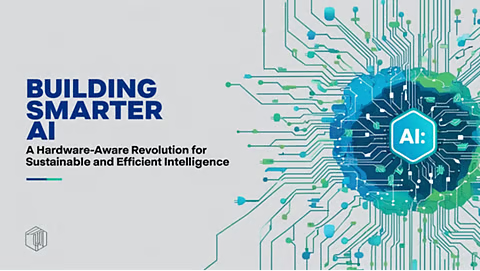

Every time you ask your phone's voice assistant a question, an AI model wakes up in a data center, often thousands of miles away, burning more energy than you might expect. As AI scales, so do its environmental costs. This article highlights innovations championed by Nikhila Pothukuchi that improve AI efficiency and reduce environmental impact. It explores hardware aware strategies like quantization, pruning, and sparsity that optimize models for various platforms, offering a sustainable path forward for building smarter, greener AI systems without compromising performance.
Hardware aware training overcomes limitations caused by restricted resources (e.g., energy, memory, and latency) by adding constraints into the model development process. This area of research is still in its infancy but has the potential to represent a paradigm shift in how people deploy AI. One of the primary methods of hardware aware training is Neural Architecture Search (NAS). NAS is akin to an automated architect- it develops neural network designs that are optimized for the constraints of the hardware it will run on. By designing the model for the conditions in which it will be deployed, AI can be designed to run efficiently and at scale in resource-limited environments, such as on edge devices.
Quantization is revolutionizing model efficiency by reducing numerical precision, cutting model size and computational cost. Techniques like mixed precision quantization, used in both post training and quantization aware training, let layers operate at varied bit widths (FP16, INT8, or INT4). Often, accuracy versus throughput is a balancing act where trade-offs are made—sort of like going from high-definition to standard-definition video: the streams are smaller and quicker, but sufficiently clear for the task at hand! In addition, these methods improve performance on capable hardware like NVIDIA Tensor Cores, scaling to energy-efficient, sustainable AI deployment.
Deep neural networks often contain excessive redundancy, wasting memory and energy. Network pruning tackles this by systematically removing nonessential parameters, creating leaner, faster models with minimal accuracy loss. Rather than preserving every connection, these methods use weight preservation techniques that restructure the model itself for better efficiency. Advances in pruning strategies, especially through automated tools like OpenVINO and TensorFlow Model Optimization Toolkit, reduce the need for exhaustive retraining. These refined architectures accelerate inference speeds, decrease energy footprints, and extend AI capabilities to constrained hardware, much like pruning a tree: trimming unnecessary branches while keeping it strong and healthy.
Generic models commonly are not performing consistently on different hardware platforms, necessitating a need for hardware specific optimization—especially with the ongoing disparity between edge and data center deployments. Aligning the architectures of the AI system with the constraints of the end device improves performance, energy consumption, and ultimately speed. Consider a ResNet model which can run up to 15× faster on a TPU vs a CPU. These kinds of performance improvements can make a model that could not be used in practice become a real time application, relative to the architecture it targets while being integrated with the automated framework.
Sparsity introduces zero valued connections on purpose to increase the efficiency of models without sacrificing results. In practice, this means the model completes less computation, because many weights are zero and do not need to be computed. Techniques, like gradual pruning or dynamic sparse training, create models that can be run with considerably less computation but with no degradation of performance. These applications of sparsity work best on modern hardware that are optimized for sparse operations (NVIDIA Ampere or Cerebras chips). You can think of this process like when a recipe tells you to skip unnecessary steps (e.g., preheat the oven when you can just and put the food in cold). It finishes sooner and uses less energy, so sparsity is well suited to the limitations of our platform.
Through profiling and tuning parameters, performance management can complement hardware optimization to discover latent efficiencies in AI accelerators. By breaking down computations into representatve pieces, the models can better operate of specific chips when changing data flow patterning and tiling factors. The addition of those factors can lead to improved performance and lower energy consumption. Specific hardware targets can use frameworks such as Apache TVM and TensorRT, where optimization of hardware specific patterns and also aspects such as operator fusion, memory layout tuning, and controlling precision. These frameworks provide a bridge connecting the software (model) to silicon (efficient) in order to deploy sustainable, high performance models of AI.
The evolution of hardware aware AI techniques marks a pivotal step toward a sustainable and efficient technological future. By aligning model architectures with hardware capabilities, developers can reduce energy use, cut costs, and expand AI access in low power settings. These innovations support both technical and environmental goals. Tools like MLPerf’s Power Benchmark, a benchmark suite that measures the speed and energy efficiency of AI models across platforms, are becoming key standards. Continued progress in quantization, pruning, sparsity, and hardware specific strategies will shape intelligent, sustainable AI systems ahead.
In conclusion, hardware aware training is shaping the next generation of AI by combining computational efficiency with resource conscious design. Techniques such as quantization, pruning, sparsity, and hardware specific optimization are driving the development of more efficient AI systems. These methods don’t just optimize performance—they democratize AI by making it feasible for energy constrained environments, from rural clinics to low cost IoT devices. Guided by Nikhila Pothukuchi’s framework, practitioners can build models that deliver high performance while minimizing technological and environmental impact.
